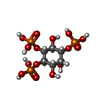+ Open data
Open data
- Basic information
Basic information
| Entry | Database: PDB / ID: 7t3t | ||||||||||||
|---|---|---|---|---|---|---|---|---|---|---|---|---|---|
| Title | IP3, ATP, and Ca2+ bound type 3 IP3 receptor in the active state | ||||||||||||
 Components Components | Inositol 1,4,5-trisphosphate receptor type 3 | ||||||||||||
 Keywords Keywords | METAL TRANSPORT / IP3 receptor / calcium signaling | ||||||||||||
| Function / homology |  Function and homology information Function and homology informationDAG and IP3 signaling / inositol 1,3,4,5 tetrakisphosphate binding / sensory perception of bitter taste / inositol 1,4,5-trisphosphate-gated calcium channel activity / platelet dense tubular network membrane / sensory perception of umami taste / Effects of PIP2 hydrolysis / sensory perception of sweet taste / PLC beta mediated events / Elevation of cytosolic Ca2+ levels ...DAG and IP3 signaling / inositol 1,3,4,5 tetrakisphosphate binding / sensory perception of bitter taste / inositol 1,4,5-trisphosphate-gated calcium channel activity / platelet dense tubular network membrane / sensory perception of umami taste / Effects of PIP2 hydrolysis / sensory perception of sweet taste / PLC beta mediated events / Elevation of cytosolic Ca2+ levels / inositol 1,4,5 trisphosphate binding / inositol hexakisphosphate binding / CLEC7A (Dectin-1) induces NFAT activation / transport vesicle membrane / cytoplasmic side of endoplasmic reticulum membrane / intracellularly gated calcium channel activity / brush border / nuclear outer membrane / Role of phospholipids in phagocytosis / calcium ion homeostasis / Ion homeostasis / release of sequestered calcium ion into cytosol / FCERI mediated Ca+2 mobilization / phosphatidylinositol binding / FCGR3A-mediated IL10 synthesis / Antigen activates B Cell Receptor (BCR) leading to generation of second messengers / secretory granule membrane / sarcoplasmic reticulum / VEGFR2 mediated cell proliferation / Regulation of insulin secretion / response to calcium ion / platelet activation / memory / long-term synaptic potentiation / apical part of cell / Sensory perception of sweet, bitter, and umami (glutamate) taste / Glucagon-like Peptide-1 (GLP1) regulates insulin secretion / sensory perception of taste / positive regulation of cytosolic calcium ion concentration / Ca2+ pathway / protein homotetramerization / receptor complex / G protein-coupled receptor signaling pathway / neuronal cell body / calcium ion binding / endoplasmic reticulum membrane / nucleolus / endoplasmic reticulum / zinc ion binding / nucleoplasm / ATP binding / membrane / plasma membrane / cytoplasm Similarity search - Function | ||||||||||||
| Biological species |  Homo sapiens (human) Homo sapiens (human) | ||||||||||||
| Method | ELECTRON MICROSCOPY / single particle reconstruction / cryo EM / Resolution: 3.8 Å | ||||||||||||
 Authors Authors | Schmitz, E.A. / Takahashi, H. / Karakas, E. | ||||||||||||
| Funding support |  United States, 3items United States, 3items
| ||||||||||||
 Citation Citation |  Journal: Nat Commun / Year: 2022 Journal: Nat Commun / Year: 2022Title: Structural basis for activation and gating of IP receptors. Authors: Emily A Schmitz / Hirohide Takahashi / Erkan Karakas /  Abstract: A pivotal component of the calcium (Ca) signaling toolbox in cells is the inositol 1,4,5-triphosphate (IP) receptor (IPR), which mediates Ca release from the endoplasmic reticulum (ER), controlling ...A pivotal component of the calcium (Ca) signaling toolbox in cells is the inositol 1,4,5-triphosphate (IP) receptor (IPR), which mediates Ca release from the endoplasmic reticulum (ER), controlling cytoplasmic and organellar Ca concentrations. IPRs are co-activated by IP and Ca, inhibited by Ca at high concentrations, and potentiated by ATP. However, the underlying molecular mechanisms are unclear. Here we report cryo-electron microscopy (cryo-EM) structures of human type-3 IPR obtained from a single dataset in multiple gating conformations: IP-ATP bound pre-active states with closed channels, IP-ATP-Ca bound active state with an open channel, and IP-ATP-Ca bound inactive state with a closed channel. The structures demonstrate how IP-induced conformational changes prime the receptor for activation by Ca, how Ca binding leads to channel opening, and how ATP modulates the activity, providing insights into the long-sought questions regarding the molecular mechanism underpinning receptor activation and gating. | ||||||||||||
| History |
|
- Structure visualization
Structure visualization
| Structure viewer | Molecule:  Molmil Molmil Jmol/JSmol Jmol/JSmol |
|---|
- Downloads & links
Downloads & links
- Download
Download
| PDBx/mmCIF format |  7t3t.cif.gz 7t3t.cif.gz | 1.5 MB | Display |  PDBx/mmCIF format PDBx/mmCIF format |
|---|---|---|---|---|
| PDB format |  pdb7t3t.ent.gz pdb7t3t.ent.gz | Display |  PDB format PDB format | |
| PDBx/mmJSON format |  7t3t.json.gz 7t3t.json.gz | Tree view |  PDBx/mmJSON format PDBx/mmJSON format | |
| Others |  Other downloads Other downloads |
-Validation report
| Summary document |  7t3t_validation.pdf.gz 7t3t_validation.pdf.gz | 2.1 MB | Display |  wwPDB validaton report wwPDB validaton report |
|---|---|---|---|---|
| Full document |  7t3t_full_validation.pdf.gz 7t3t_full_validation.pdf.gz | 2.2 MB | Display | |
| Data in XML |  7t3t_validation.xml.gz 7t3t_validation.xml.gz | 216.1 KB | Display | |
| Data in CIF |  7t3t_validation.cif.gz 7t3t_validation.cif.gz | 331.5 KB | Display | |
| Arichive directory |  https://data.pdbj.org/pub/pdb/validation_reports/t3/7t3t https://data.pdbj.org/pub/pdb/validation_reports/t3/7t3t ftp://data.pdbj.org/pub/pdb/validation_reports/t3/7t3t ftp://data.pdbj.org/pub/pdb/validation_reports/t3/7t3t | HTTPS FTP |
-Related structure data
| Related structure data |  25670MC 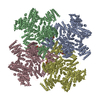 7t3pC 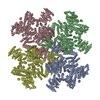 7t3qC 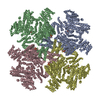 7t3rC  7t3uC C: citing same article ( M: map data used to model this data |
|---|---|
| Similar structure data | Similarity search - Function & homology  F&H Search F&H Search |
- Links
Links
- Assembly
Assembly
| Deposited unit | 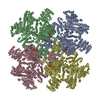
|
|---|---|
| 1 |
|
- Components
Components
| #1: Protein | Mass: 299325.875 Da / Num. of mol.: 4 Source method: isolated from a genetically manipulated source Source: (gene. exp.)  Homo sapiens (human) / Gene: ITPR3 / Production host: Homo sapiens (human) / Gene: ITPR3 / Production host:  #2: Chemical | ChemComp-ZN / #3: Chemical | ChemComp-I3P / #4: Chemical | ChemComp-ATP / #5: Chemical | ChemComp-CA / Has ligand of interest | Y | Has protein modification | Y | |
|---|
-Experimental details
-Experiment
| Experiment | Method: ELECTRON MICROSCOPY |
|---|---|
| EM experiment | Aggregation state: PARTICLE / 3D reconstruction method: single particle reconstruction |
- Sample preparation
Sample preparation
| Component | Name: Inositol 1,4,5-trisphosphate receptor type 3 / Type: COMPLEX / Entity ID: #1 / Source: RECOMBINANT | ||||||||||||||||||||||||||||||||||||||||||||||||||
|---|---|---|---|---|---|---|---|---|---|---|---|---|---|---|---|---|---|---|---|---|---|---|---|---|---|---|---|---|---|---|---|---|---|---|---|---|---|---|---|---|---|---|---|---|---|---|---|---|---|---|---|
| Molecular weight | Value: 1.2 MDa / Experimental value: NO | ||||||||||||||||||||||||||||||||||||||||||||||||||
| Source (natural) | Organism:  Homo sapiens (human) Homo sapiens (human) | ||||||||||||||||||||||||||||||||||||||||||||||||||
| Source (recombinant) | Organism:  | ||||||||||||||||||||||||||||||||||||||||||||||||||
| Buffer solution | pH: 8 Details: IP3, ATP, and CaCl2 were added before cryo-grid preparation. | ||||||||||||||||||||||||||||||||||||||||||||||||||
| Buffer component |
| ||||||||||||||||||||||||||||||||||||||||||||||||||
| Specimen | Conc.: 1.8 mg/ml / Embedding applied: NO / Shadowing applied: NO / Staining applied: NO / Vitrification applied: YES | ||||||||||||||||||||||||||||||||||||||||||||||||||
| Specimen support | Grid material: COPPER / Grid mesh size: 300 divisions/in. / Grid type: Quantifoil R1.2/1.3 | ||||||||||||||||||||||||||||||||||||||||||||||||||
| Vitrification | Instrument: FEI VITROBOT MARK IV / Cryogen name: ETHANE / Humidity: 100 % / Chamber temperature: 281 K |
- Electron microscopy imaging
Electron microscopy imaging
| Experimental equipment |  Model: Titan Krios / Image courtesy: FEI Company |
|---|---|
| Microscopy | Model: FEI TITAN KRIOS |
| Electron gun | Electron source:  FIELD EMISSION GUN / Accelerating voltage: 300 kV / Illumination mode: FLOOD BEAM FIELD EMISSION GUN / Accelerating voltage: 300 kV / Illumination mode: FLOOD BEAM |
| Electron lens | Mode: BRIGHT FIELD / Nominal magnification: 105000 X / Nominal defocus max: 1600 nm / Nominal defocus min: 800 nm |
| Image recording | Electron dose: 60 e/Å2 / Film or detector model: GATAN K3 BIOQUANTUM (6k x 4k) / Num. of grids imaged: 4 / Num. of real images: 42361 |
- Processing
Processing
| EM software |
| ||||||||||||||||||||||||||||||
|---|---|---|---|---|---|---|---|---|---|---|---|---|---|---|---|---|---|---|---|---|---|---|---|---|---|---|---|---|---|---|---|
| CTF correction | Type: PHASE FLIPPING AND AMPLITUDE CORRECTION | ||||||||||||||||||||||||||||||
| 3D reconstruction | Resolution: 3.8 Å / Resolution method: FSC 0.143 CUT-OFF / Num. of particles: 20039 / Num. of class averages: 1 / Symmetry type: POINT | ||||||||||||||||||||||||||||||
| Atomic model building | Protocol: FLEXIBLE FIT / Space: REAL | ||||||||||||||||||||||||||||||
| Atomic model building | PDB-ID: 6UQK Accession code: 6UQK / Source name: PDB / Type: experimental model |
 Movie
Movie Controller
Controller







 PDBj
PDBj





















